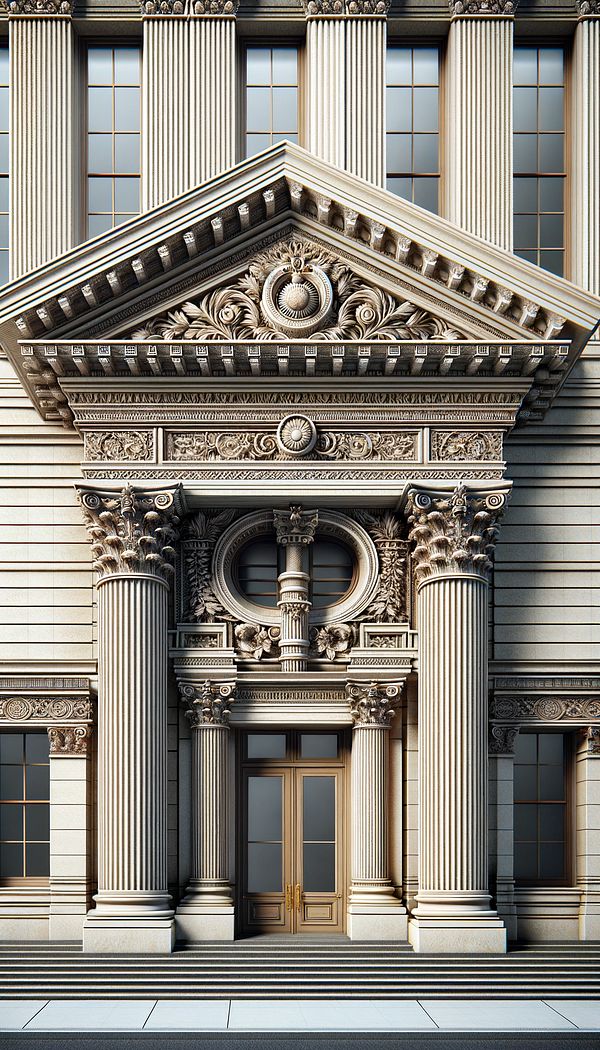What is a Pediment?
A pediment is a triangular upper part of a building in classical architecture, often found above the horizontal structure of the entablature.
Description
A pediment is a significant architectural element that forms a vital part of classical buildings, defining their silhouette and adding to their grandeur. It is essentially a triangular gable found atop columns or a horizontal structure known as the entablature, which rests on columns. Pediments were primarily used in ancient Greek and Roman architecture but have been adapted into various architectural styles throughout history, including neoclassical and colonial revival styles.
The peak of the pediment often contains a decorative sculpture or relief, which typically depicts mythological or historical scenes, adding narrative and ornamental value to the structure. The spaces within the pediment, known as the tympanum, serve as a canvas for these artistic expressions. The sides of the pediment are framed by moldings, enhancing its architectural presence and adding depth to the building's façade.
In contemporary design, the use of a pediment might not be as prevalent as in classical architecture. However, its influence can be seen in various forms, from the grand entrance ways of neoclassical buildings to the more subtle interpretations in modern homes, where it may be used to add a touch of elegance and historical reference.
Understanding the structural and decorative aspects of a pediment can enrich one's appreciation of architectural beauty. It serves as a reminder of the classical heritage that continues to influence modern design.
Usage
Originally, pediments were seen atop Greek temples and Roman buildings, providing both structural support and decorative appeal. Today, they can be found in various architectural contexts, from the impressive façades of neoclassical government buildings and museums to the more understated use in residential homes. Pediments also make appearances in interior design, where they might adorn mantelpieces, bookcases, or window treatments, serving as a nod to classical elegance within contemporary settings.
FAQs
-
Are pediments only found in classical architecture?
No, while pediments originate from classical architecture, their design elements have been incorporated into various architectural styles over the centuries, including neoclassical, colonial revival, and even some modern designs.
-
What is the purpose of the decorative elements in a pediment?
The decorative elements, typically found in the tympanum or peak of a pediment, serve both an ornamental and narrative purpose. They often depict mythological, historical, or allegorical scenes, adding depth and context to the building's design.
-
Can pediments be used in interior design?
Yes, pediments are not limited to exterior architecture; they can also be incorporated into interior design elements such as over doorways, on mantelpieces, or atop furniture like bookcases, adding a classical touch to interior spaces.
Practical Application
When incorporating pediments into architectural or interior design, attention should be paid to the scale and style of the surrounding elements to ensure harmony. For example, a pediment used above a door or window should proportionally fit the space, complementing rather than overwhelming it. Considering the style of the pediment's decoration can also help align it with the overall design narrative, whether aiming for a historical accuracy or a more contemporary adaptation.
-
Architectural Elements199 articles
-
Design Styles478 articles
-
Decorative Techniques322 articles
-
Historical Periods & Movements150 articles
-
Wall Treatments & Finishes157 articles
-
RetroRetro refers to a style that draws inspiration from the past, specifically from the 1950s to the 1970s.
-
Hand DistressingHand distressing is a decorative technique used to give new furniture or materials an aged or weathered appearance.
-
Tertiary ColorA color created by mixing one primary color with one secondary color.
-
Art DecoArt Deco is a design style characterized by bold geometric shapes, rich colors, and lavish ornamentation.
-
ReliefIn interior design, relief refers to a method of molding, carving, or stamping in which the design stands out from the surface.
